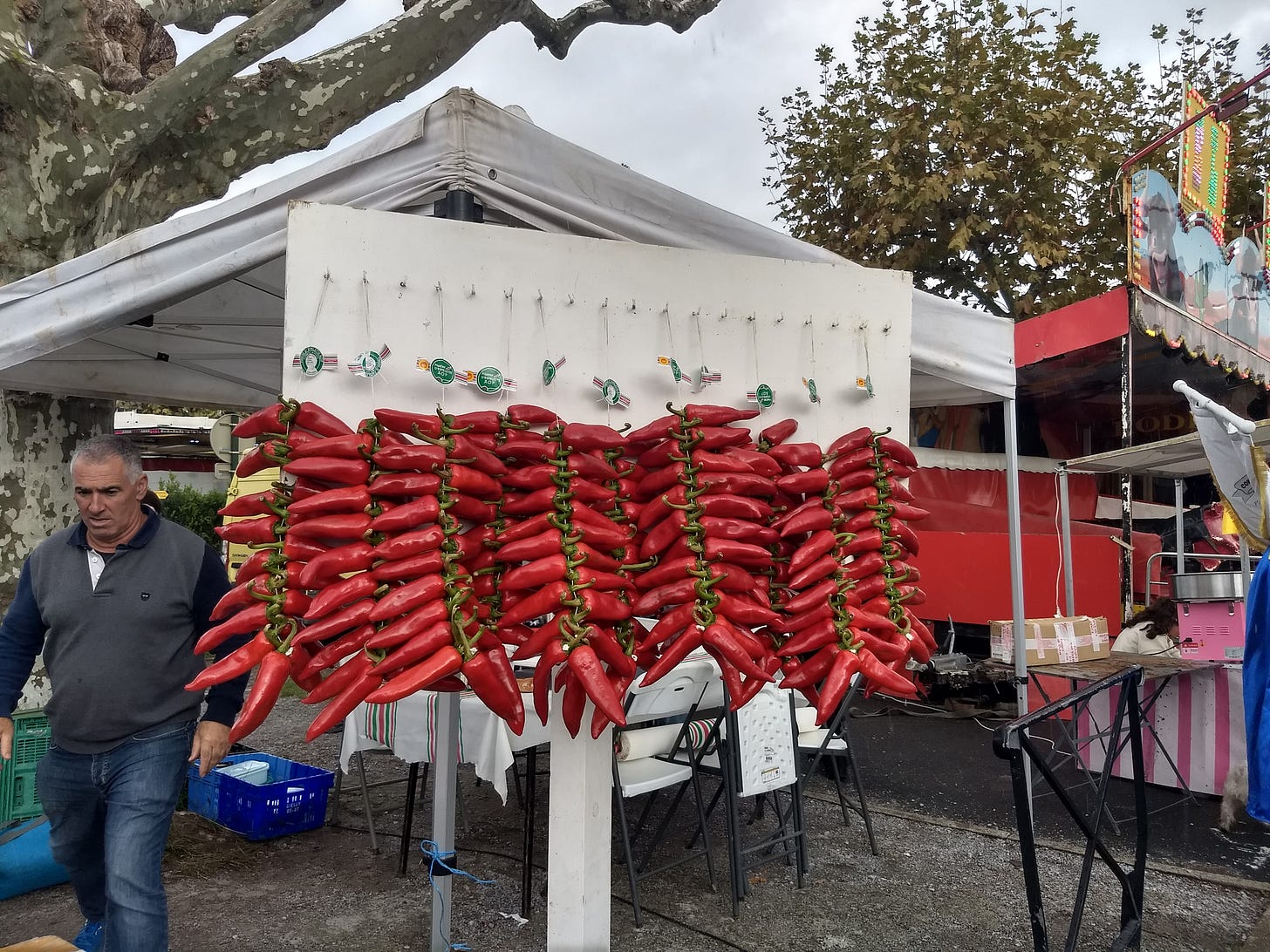Where Basque Tradition Meets Heat: A Day at the Piment d’Espelette Festival
How a Mexican pepper found a home in Espelette—and inspired one of France’s most vibrant festivals.
It’s a fruit to be reckoned with: brilliant in color, sweet-tasting with a hint of bitterness, medium spicy progressing in intensity as it lingers in the mouth. The Piment d’Espelette is one of the most important and best-known symbols of the Basque Country, cultivated with loving care and pride for centuries in southwest France.
So when I heard the annual Fête du Piment was taking place in nearby Espelette, a picturesque village nestled in the foothills of the Pyrenees, I made my plans.
Due to the scarcity of available parking, we left our car at a farm in a nearby village, then took a shuttle to the festival location. Not only were passenger vehicles parked at a distance from Espelette, but numerous tour buses from other areas also had designated parking. That made sense when we learned that an estimated 20,000 visitors would attend over the course of the two-day event. As our driver dropped us off, he said to note where we were (Zone B) and that the last shuttle pickup was at 8:00 p.m. It was just early afternoon, so there would be plenty of time to stroll, eat, drink, and shop.
The Fête du Piment is organized by the Confrérie du Piment d’Espelette, a brotherhood founded in 1969, which promotes and raises awareness of chili peppers. We were there on Sunday, the second day of the festival, when the Confrérie invited other brotherhoods from the region to take part in a colorful parade. Afterwards, an induction ceremony for new members would take place, as well as the awarding of the Chili Pepper Prize. Earlier, there had been a solemn mass at Saint Stephen’s church, a chorale presentation, drumming fanfare, and a blessing of the peppers. There would be strolling musicians, regional products for sale all day, and in late afternoon, a bare-handed Basque pelota game.
Anticipating that we would make some purchases, our first step was the acquisition of a souvenir burlap tote bag. Next, we bought one of the picture-perfect strings of peppers so prominently displayed at numerous stands, which are hung to dry outside the traditional red and green half-timbered houses in town. Passing an appetizing food stand, I made a note that later I would treat myself to a baguette with brebis, an aged, hard local cheese (€5,50) and a glass of wine (€2,50).
But first I wanted to know—why all the fuss about this plucky pepper? Is it native to Basque Country? If not, where was its origin?
At the Interpretation Center on the grounds, we learned that the chili traveled from Mexico to Europe with Christopher Columbus, making its debut in France in the 16th century. By 1650, it happily took root in the welcoming climate around Espelette in the Basque region: significant rainfall, mild temperatures, and the famous “Haize Hegoa” southerly wind.
We read about the European certification that guarantees the authenticity and quality of Piment d’Espelette: AOP stands for Appellation d’Origine Protégée (Protected Designation of Origin). The Scoville Scale measures the pungency of peppers, and Piment d’Espelette is four on a scale of ten, which gives it its subtle warm—not hot—quality.
Afterwards we strolled around, passing clusters of visitors sipping glasses of chilled white wine. Various kiosks offered everything from jewelry to soaps to kambucha to grilled meats. We debated about the purchase of some Gâteau Basque, a simple flat cake spread with either black cherry jam or pastry cream, then topped with a second flat disc of cake.
But what really got my attention was a stand serving cups of Aligot de l’Aubrac, a creamy, melted concoction. The cheese, Tome de Laguiole, comes from the Massif Central plateau in south-central France, a famed cattle region. The Irish in me was interested in the potatoes involved. In addition to cheese and potatoes, the cup, priced at €5, also consists of butter, heavy cream, and a hint of garlic. (Basically, it’s your calorie allotment, not for several meals, but for several days.) Its history dates back to the Middle Ages, when the monks of Aubrac offered a soup made of bouillon, bread, and fresh cheese to pilgrims on the Way of Saint James, ending in Compostela, Spain.
Branching off from the steady stream of tourists, we stopped to check out the goodies in a health food store in town. There were various organic items available—produce, meats, and cheeses. We came away with two small steaks, piment-flavored potato chips, and a jar of spices featuring, of course, the ubiquitous chili pepper.
Three hours had passed since our arrival, and now I had no room for a sandwich. We were ready to head back to Zone B, armed with our treasures, photos, videos, and memories.
If you’re interested in joining the festivities next year, I suggest making reservations for lodging well in advance. The dates for the Fête du Piment 2026 have not yet been set, but generally, it occurs on the final weekend of October. One thing is for sure: Espelette will continue its time-honored tradition, and locals and visitors alike will once again savor it all.
— Tricia Pimental, a former actress and Toastmaster, who has written two memoirs and a novel in addition to two books on Portugal.
Thinking about exploring France beyond the usual stops? Discover hidden gems like Espelette and get insider advice on living abroad with International Living. Subscribe here today.




